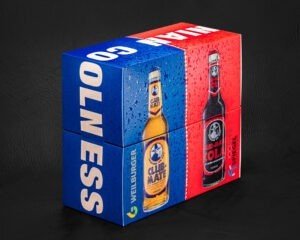Showcasing a sustainable alternative for food packaging – that was the aim of the new demo project by Weilburger Graphics. The company created an innovative and recyclable beverage cooler made from paperboard and using a completely new waterproof coating. For the material, they chose Metsä Board’s, part of Metsä Group, lightweight, fresh fiber paperboard. The packaging comes with a cooling tray, and that can take up to 500 grams of crushed ice or cold water. MetsäBoard Prime FBB EB eco-barrier paperboard was used with Weilburger Graphics’ new Senolith water-based barrier coating to keep the water inside the cooler.

“Many of our customers, especially in the food, cooling, and frozen food sectors, are looking for environmentally friendly packaging solutions that are also safe for direct food contact. Often these solutions need to be waterproof,” says Arno Dürr, Sales director at Weilburger Graphics GmbH, an international coating, flexo inks, and adhesive manufacturer based in Germany.
The main body of the box, including a bottom and a cover, was made of MetsäBoard Classic FBB 340 grams per square meters, while the special cooling tray, as well as the compartment separator for easy fill-up was made of Metsä Boards eco-barrier paperboard MetsäBoard Prime FBB EB 265 grams per square meters.

“Both the idea and the implementation turned out very well. The result was a sustainable alternative to conventional packaging methods, which also has an impressive feel and look. In the future, this kind of package might be an option also for fresh fruit and other foods that need to be chilled,” says Gabriel Goldmayer, Account director at Metsä Board.
Fresh fiber paperboards usually tolerate humidity better than recycled fiber-based grades. They are also lighter, and therefore enable a lower carbon footprint of the packaging. After use, they are recyclable, contributing hence to circular economy.
IndiFoodBev — authentic, impactful and influential
An English-language food and beverage processing and packaging industry B2B platform in print and web, IndiFoodBev is in its third year of publication. It is said that the Indian food and beverage industries represent approximately US$ 900 billion in revenues which implies more than 20% of the country’s GDP. Eliminating the wastage on the farmside can help to deliver more protein to a higher number of the population apart from generating sizable exports. The savings in soil, seeds, water, fertilizer, energy and ultimately food and nutrition could be the most immense contribution that country is poised to make to the moderation of climate change.
To improve your marketing and grow sales to the food and beverage processing and packaging industry, talk to us. Our research and consulting company IppStar [www.ippstar.org] can assess your potential and addressable markets in light of the competition. We can discuss marketing, communication, and sales strategies for market entry and growth.
Suppliers and service providers with a strategy and budget for targeted marketing can discuss using our hybrid print, web, video, and social media channels to create brand recognition linked to market relevance. Our technical writers are ready to meet you and your customers for content.
The second largest producer of fruit and vegetables in the world is continuously expanding processing capacities and delivery systems with appropriate innovative technologies. We cover product and consumer trends, nutrition, processing, research, equipment and packaging from farm to thali. Get our 2025 media kit and recalibrate your role in this dynamic market. Enhance your visibility and relevance to existing markets and turn potential customers into conversations. Ask for a sample copy of our bi-monthly in print or our weekly IndiFoodBev eZine each Wednesday.
For editorial info@ippgroup.in — for advertisement ads1@ippgroup.in and for subscriptions subscription@ippgroup.in
Naresh Khanna – 10 February 2025
Subscribe Now











